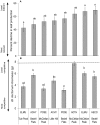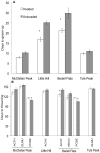Native perennial grasses show evolutionary response to Bromus tectorum (cheatgrass) invasion
- PMID: 21479185
- PMCID: PMC3068177
- DOI: 10.1371/journal.pone.0018145
Native perennial grasses show evolutionary response to Bromus tectorum (cheatgrass) invasion
Abstract
Invasive species can change selective pressures on native plants by altering biotic and abiotic conditions in invaded habitats. Although invasions can lead to native species extirpation, they may also induce rapid evolutionary changes in remnant native plants. We investigated whether adult plants of five native perennial grasses exhibited trait shifts consistent with evolution in response to invasion by the introduced annual grass Bromus tectorum L. (cheatgrass), and asked how much variation there was among species and populations in the ability to grow successfully with the invader. Three hundred and twenty adult plants were collected from invaded and uninvaded communities from four locations near Reno, Nevada, USA. Each plant was divided in two and transplanted into the greenhouse. One clone was grown with B. tectorum while the other was grown alone, and we measured tolerance (ability to maintain size) and the ability to reduce size of B. tectorum for each plant. Plants from invaded populations consistently had earlier phenology than those from uninvaded populations, and in two out of four sites, invaded populations were more tolerant of B. tectorum competition than uninvaded populations. Poa secunda and one population of E. multisetus had the strongest suppressive effect on B. tectorum, and these two species were the only ones that flowered in competition with B. tectorum. Our study indicates that response to B. tectorum is a function of both location and species identity, with some, but not all, populations of native grasses showing trait shifts consistent with evolution in response to B. tectorum invasion within the Great Basin.
Conflict of interest statement
Figures




Similar articles
-
The adaptive value of remnant native plants in invaded communities: an example from the Great Basin.Ecol Appl. 2008 Jul;18(5):1226-35. doi: 10.1890/07-1598.1. Ecol Appl. 2008. PMID: 18686583
-
Effects of precipitation change and neighboring plants on population dynamics of Bromus tectorum.Oecologia. 2015 Nov;179(3):765-75. doi: 10.1007/s00442-015-3398-z. Epub 2015 Jul 31. Oecologia. 2015. PMID: 26227366
-
Plastic responses of native plant root systems to the presence of an invasive annual grass.Am J Bot. 2015 Jan;102(1):73-84. doi: 10.3732/ajb.1400234. Epub 2014 Dec 30. Am J Bot. 2015. PMID: 25587150
-
Impacts and Drivers of Smooth Brome (Bromus inermis Leyss.) Invasion in Native Ecosystems.Plants (Basel). 2022 May 18;11(10):1340. doi: 10.3390/plants11101340. Plants (Basel). 2022. PMID: 35631764 Free PMC article. Review.
-
Temporal development in the impacts of plant invasions: search for the underlying mechanisms.J Evol Biol. 2024 Jun 28;37(6):588-604. doi: 10.1093/jeb/voae042. J Evol Biol. 2024. PMID: 38549561 Review.
Cited by
-
Physical disturbance shapes vascular plant diversity more profoundly than fire in the sagebrush steppe of southeastern Idaho, U.S.A.Ecol Evol. 2013 Jun;3(6):1626-41. doi: 10.1002/ece3.574. Epub 2013 Apr 28. Ecol Evol. 2013. PMID: 23789073 Free PMC article.
-
Strong natural selection during plant restoration favors an unexpected suite of plant traits.Evol Appl. 2013 Apr;6(3):510-23. doi: 10.1111/eva.12038. Epub 2013 Jan 3. Evol Appl. 2013. PMID: 23745142 Free PMC article.
-
The more the better? The role of polyploidy in facilitating plant invasions.Ann Bot. 2012 Jan;109(1):19-45. doi: 10.1093/aob/mcr277. Epub 2011 Oct 31. Ann Bot. 2012. PMID: 22040744 Free PMC article. Review.
-
Concordant Signal of Genetic Variation Across Marker Densities in the Desert Annual Chylismia brevipes Is Linked With Timing of Winter Precipitation.Evol Appl. 2024 Dec 16;17(12):e70046. doi: 10.1111/eva.70046. eCollection 2024 Dec. Evol Appl. 2024. PMID: 39691745 Free PMC article.
-
Spatial pattern of invasion and the evolutionary responses of native plant species.Evol Appl. 2016 Jul 17;9(8):939-51. doi: 10.1111/eva.12398. eCollection 2016 Sep. Evol Appl. 2016. PMID: 27606003 Free PMC article.
References
-
- D'Antonio CM, Vitousek PM. Biological invasions by exotic grasses, the grass-fire cycle, and global change. Annual Review of Ecology and Systematics. 1992;23:63–87.
-
- Crooks J. Characterizing the ecosystem-level consequences of biological invasions: the role of ecosystem engineers. OIKOS. 2002;97:153–166.
-
- Walker L, Vitousek P. An invader alters germination and growth of a native dominant tree in Hawaii. Ecology. 1991;72:1449–1455.
-
- Gonzalez A, Lambert A, Ricciardi A. When does ecosystem engineering cause invasion and species replacement? Oikos. 2008;117:1247–1257.
Publication types
MeSH terms
LinkOut - more resources
Full Text Sources

